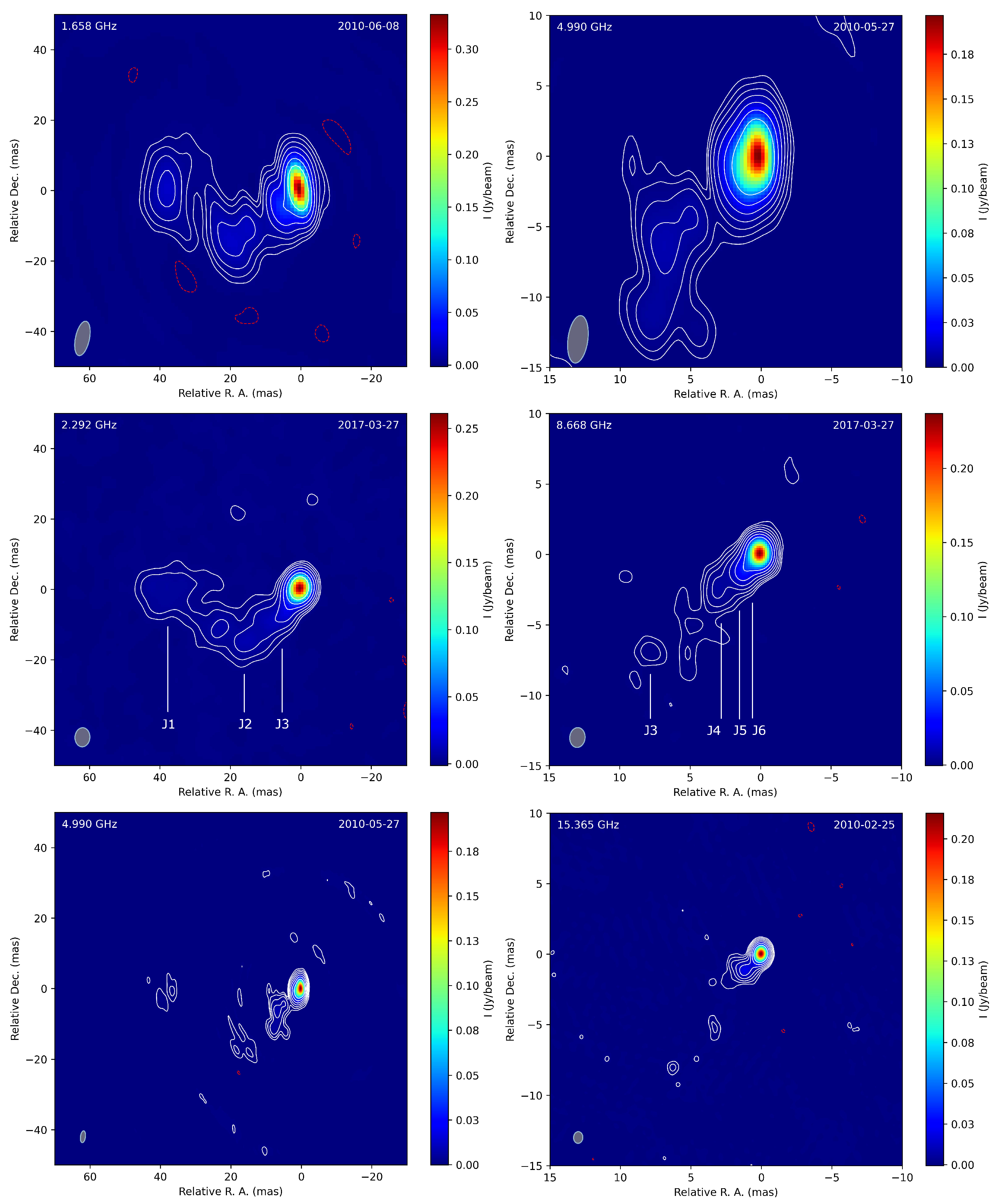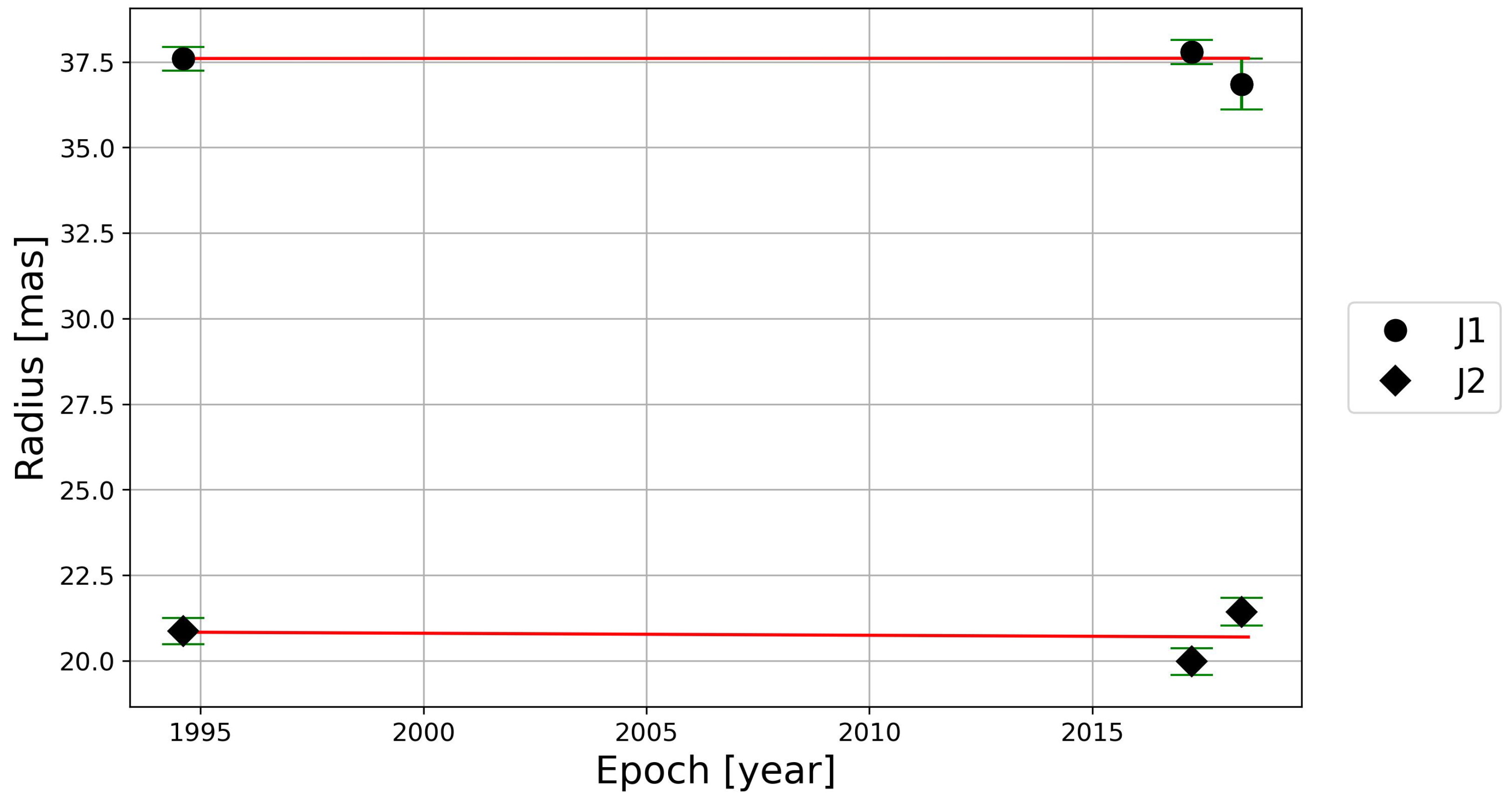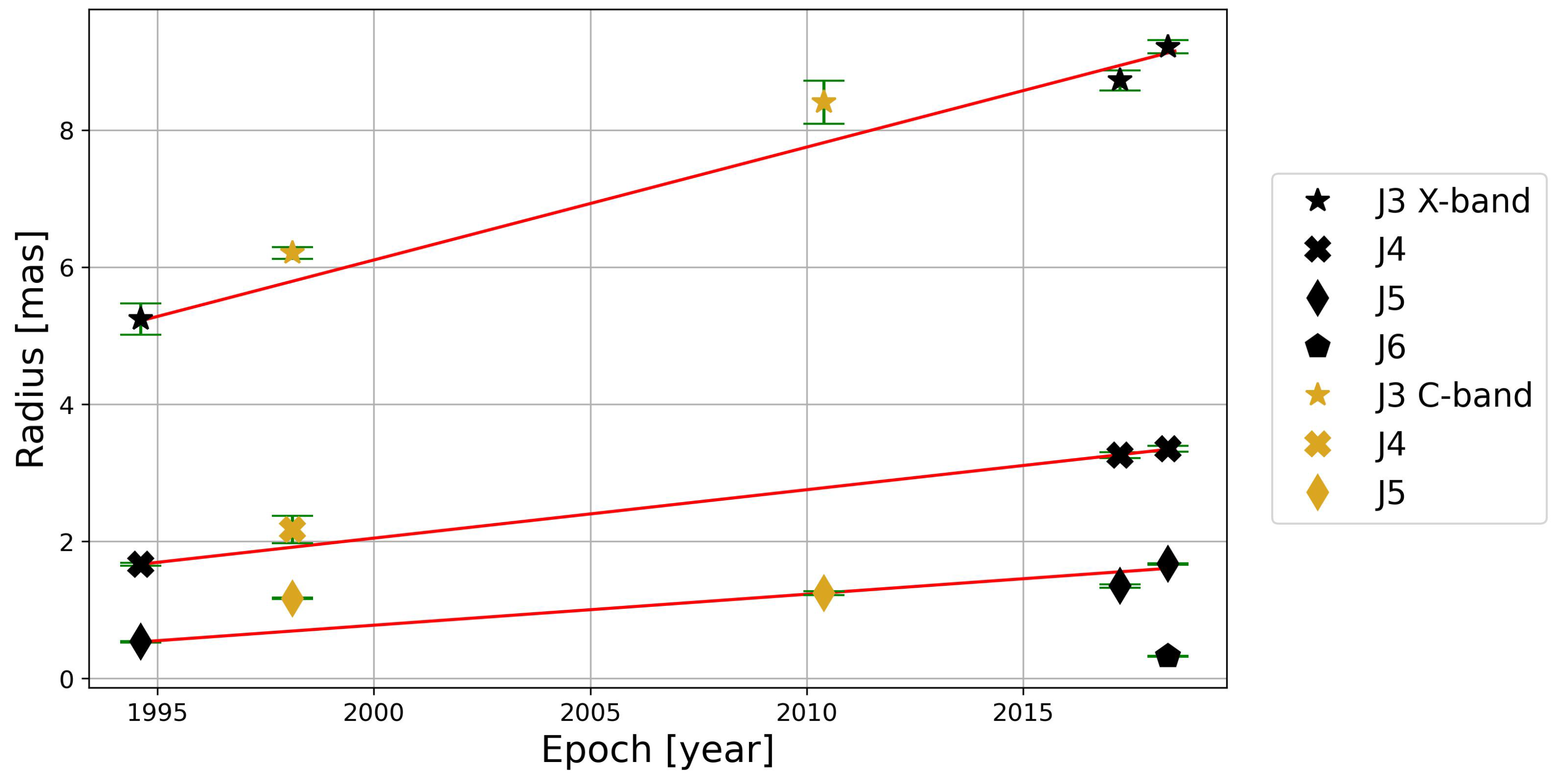1. Introduction
The largely unexplored, high-redshift (
) domain of the Universe is key to understanding the evolution of active galactic nuclei (AGN) [
1]. By analysing these objects, we can determine whether AGN in the early Universe functioned similarly to those in our local cosmic neighbourhood.
Supermassive black holes (SMBHs) are an essential component of AGN. These black holes have masses ranging from approximately
to
solar masses [
2] and are believed to reside at the center of every major galaxy [
3]. As matter spirals into the SMBH, the galactic core can reach extremely high bolometric luminosities (
∼
erg s
−1), thousands of times brighter than an entire normal galaxy [
2]. Under the influence of the strong magnetic field, not all of the accreted plasma falls into the SMBH; instead, some material is ejected along the SMBH spin axis at relativistic speeds [
4]. The magnetic field collimates this outflow into bipolar relativistic jets [
4]. The charged particles experience acceleration along helical trajectories due to the Lorentz force in the magnetic field. As a result, they emit synchrotron radiation that can be detected in the radio [
5]. The reason why only ≲
[
6] of known AGN are radio-loud and “jetted” is still an open question [
7,
8].
The technique of very long baseline interferometry (VLBI) [
9] uses coordinated observations performed by an extended network of radio telescopes to achieve the highest possible angular resolution. With a global VLBI array, resolutions of around a milliarcsecond (mas) can be achieved at cm wavelengths. In many AGN, instead of symmetric two-sided jets, strongly asymmetric structures are observed with VLBI. The appearance of one-sided core–jet structures is attributed to Doppler beaming, a relativistic effect where the emission from the approaching jet closely aligned with the observer’s line of sight is boosted, while the emission from the opposite (receding) jet is diminished [
10].
In blazars, the jet is viewed at an angle of 10° or less [
11], causing its Doppler-boosted emission to dominate the spectral energy distribution. Blazars are further categorized into two main types: BL Lac objects and flat-spectrum radio quasars (FSRQs). FSRQs exhibit strong and broad optical emission lines, whereas BL Lac objects have weak or no optical emission lines as they are suppressed by the continuum. Additionally, FSRQs possess higher bolometric luminosities [
12]. As a result, they dominate the known high-redshift (
) blazar population, as they are significantly brighter than BL Lac objects.
Some studies suggest that SMBHs grow faster in jetted quasars compared to radio-quiet AGN [
13], indicating a connection between jet activity and black hole growth [
14]. The most distant known blazar has a redshift of nearly
[
15], while AGN have been discovered with redshifts as high as
[
16]. However, jetted AGN do not appear to be dominant in the early Universe, as they have only been observed up to
[
17]. Radio-loud quasars are rare even beyond
, based on current observations [
18].
According to a recent work [
19], the number of radio quasars at
whose jet kinematics and physics have been studied by means of multi-epoch high-resolution VLBI observations is currently about 50 [
20,
21,
22,
23,
24,
25,
26,
27,
28]. The VLBI jet kinematic analysis of the flat-spectrum radio quasar [
29] J1429+5406 (TXS 1427+543) presented here provides a valuable addition to the sample studied to date, offering an interesting comparison with other high-redshift jetted AGN. The right ascension and declination coordinates of the object in the VLBI-based International Celestial Reference Frame [
30] are RA
and DEC
, respectively, at 2015.0 as the reference epoch. We consider the spectroscopic redshift determined recently as
based on measurements from the Dark Energy Spectroscopic Instrument [
31]. The radio source has a two-point spectral index of
[
32] (following the convention
, where
S is the flux density and
the observing frequency). The flux densities of J1429+5406 are 1165 mJy at
GHz in the FIRST (Faint Images of the Radio Sky at Twenty-centimeters) survey [
33], 792 mJy at 3 GHz in the VLASS (Very Large Array Sky Survey) [
34], and 493 mJy at
GHz measured with the VLA [
35]. While the source is compact on arcsecond scales [
33,
34],
-GHz VLA imaging at ∼
resolution revealed an extension in the 110° position angle [
35]. The source was also detected in X-rays by
ROSAT with the flux of
erg s
−1 cm
−2 in the (0.1–2.4) keV band [
36] and in
-rays by the
Fermi Large Area Telescope [
1,
37]. It is faint in the optical, with apparent magnitude
[
38].
Here we present the analysis of archival multi-frequency VLBI observations of J1429+5406 obtained between 1994 and 2018.
Section 2 details the observations and data reduction,
Section 3 presents the results,
Section 4 provides a discussion, and
Section 5 summarizes our findings.
Throughout this paper, we assume a standard flat
Cold Dark Matter cosmological model with parameters
,
, and
[
39]. In this model, the luminosity distance of J1429+5406 is
Mpc and 1 mas angular size corresponds to
pc projected linear size at
[
40].
2. Observations and Data Analysis
Most of the datasets analyzed here were observed with the Very Long Baseline Array (VLBA). This network consists of ten 25 m diameter antennas in the United States: Brewster (BR), Fort Davis (FD), Hancock (HN), Kitt Peak (KP), Los Alamos (LA), North Liberty (NL), Owens Valley (OV), Pie Town (PT), Mauna Kea (MK), and St. Croix (SC). These calibrated visibility data were obtained from the Astrogeo database (
https://astrogeo.org/cgi-bin/imdb_get_source.csh?source=J1429%2B5406, accessed on 18 April 2025). In addition, two datasets were obtained using the European VLBI Network (EVN). The following radio telescopes were involved in at least one EVN observation: Effelsberg (EF; Germany), Jodrell Bank Lovell and Mk2 telescopes (JB and JV; United Kingdom), Medicina (MC; Italy), Toruń (TR; Poland), Onsala (ON; Sweden), Sheshan and Nanshan (SH and UR; China), Badary and Zelenchukskaya (BD and ZC; Russia), and the phased array of the Westerbork Synthesis Radio Telescope (WB; The Netherlands). The EVN data were obtained in the project EF022 (PI: S. Frey) in 2010, when J1429+5406 was used as a phase-reference calibrator for the nearby faint radio quasar J1429+5447 at an extremely high redshift (
) [
41]. Altogether, the five observed frequency bands were
,
, 5, 8.3–8.7, and
GHz (L, S, C, X, and U bands, respectively). For the sake of simplicity, we collectively refer to the frequency of X-band observations as 8 GHz hereafter. The observing parameters for each dataset are collected in
Table 1, where the participating antennas are listed by their two-letter station codes. The minus sign preceding a VLBA station code indicates a telescope not included in the network.
The visibility data downloaded from the Astrogeo archive have previously undergone initial amplitude and phase calibration, as well as the EVN data obtained in the experiment EF022 [
41]. We imported these data to the
Difmap program [
42] for imaging and model fitting. To produce the VLBI images of J1429+5406, we used conventional hybrid mapping with cycles of
clean deconvolution [
43] and self-calibration [
44]. Finally, to quantitatively characterize the brightness distribution, we fitted circular two-dimensional Gaussian model components [
45] directly to the self-calibrated visibility data.
Table 1.
Details of VLBI observations of J1429+5406.
Table 1.
Details of VLBI observations of J1429+5406.
| Epoch | | Stations | t | IF × BW | Project Code |
|---|
| (year) | (GHz) | | (s) | (MHz) | |
|---|
| 1994.612 * | 2.27 | VLBA | 177 | | BB023 [46] |
| 8.34 |
| 1998.122 * | 5.00 | VLBA | 2416 | | BV025A [47,48] |
| 2010.149 * | 15.37 | VLBA (–HN) | 5178 | | BG197B |
| 2010.401 | 4.99 | EF, JB, JV, MC, TR, ON, SH, UR, BD, ZC, WB | 21,105 | | EF022A [41] |
| 2010.434 | 1.66 | EF, JB, MC, TR, ON, SH, UR, BD, ZC, WB | 21,102 | | EF022B [41] |
| 2017.235 * | 2.29 | VLBA | 339 | | UF001F [49] |
| 8.67 | |
| 2018.346 * | 2.25 | VLBA (–OV) | 288 | | UG002G |
| 8.65 | |
4. Discussion
For the most recent VLBI study of
quasar jet proper motions [
19], the objects were drawn from a carefully defined initial sample of 102 high-redshift quasars [
57]. Apart from requiring
, the other primary selection criteria were the total flux density at
GHz exceeding 100 mJy, and the declination between
and
. The subject of our study, the quasar J1429+5406, also has high
GHz flux density, but its declination falls just out of the range considered in [
19]. Moreover, some of its redshift measurements available in the literature, ranging from
[
58] to
[
59], are slightly lower than 3. Nevertheless, it is physically similar to the AGN studied in [
19], and therefore, its derived properties can be compared to those of the sample objects.
Concerning the angular extent of its radio jet structure on VLBI scales, nearly 40 mas, J1429+5406 is among the larger jetted quasars at
, although we know a couple of more extended objects as well, e.g., [
60,
61,
62]. Based on our brightness distribution models (
Table A2), the outer steep-spectrum components J1 and J2 seen in the lower-frequency images (
Figure 1) exhibit no detectable proper motion (≲0.05 mas year
−1) in the observed period (
Figure 3). This could be a combined effect of the relatively poorer angular resolution at
GHz, the insufficient time coverage, and the diffuse nature of the emission features. A possible physical cause for the apparent lack of detectable proper motion in these outer jet components is that the emission is not Doppler-boosted, either because the jet material slows down, e.g., in a standing shock [
63] and/or it is inclined at a different angle to the line of sight than the inner (≲10 mas) section.
The remarkable jet bending as seen projected onto the sky, at ∼20 mas from the core (
Figure 1), could be caused by a sudden reorientation of the jet due to its interaction with a dense clump of the interstellar medium. Future polarization-sensitive VLBI imaging could provide evidence for this scenario [
24]. Alternatively, apparent changes in the jet direction could be due to small intrinsic variations in the spatial orientation of the jet, for example, because of precession detected in high-redshift sources as well [
64]. This could be caused by orbital motion in a binary black hole system inspiralling at the jet base, e.g., [
65]. In blazars, the small jet inclination angle causes amplification of the bending when projected onto the sky. Similar cases are not uncommon at
. In a study of a large sample, a significant fraction (
) of the jets was found to have bending with more than 90° [
19].
Unlike the outer features of J1429+5406, the three inner jet components (J3, J4, and J5;
Table A4) exhibit detectable proper motion when modeled at 8 and 5 GHz, as shown in
Figure 4. The apparent proper motion of J3 was actually measurable at both
and 8 GHz, yielding similar values. Notably, the apparent jet component speeds increase with increasing distance from the core in this inner part. Apparent jet acceleration on mas scales is common in AGN and can be either due to geometric of physical effects: a change in the jet direction with respect to the line of sight, or an increase in the intrinsic jet speed (or the bulk Lorentz factor), probably the latter being the more common effect [
66]. According to VLBI measurements, jet flow acceleration can take place up to ∼100 pc deprojected distances [
67]. Jet acceleration on pc scales can be attributed to, e.g., magnetic driving [
68] or mass loading of the magnetohydrodynamic flow [
69]. Thermal acceleration can also play a role by converting internal energy to bulk kinetic energy [
70]. Our VLBI data are rather poorly sampled in time, and therefore, we could only attempt determining linear proper motions for each individual component. Finding evidence for component acceleration, curved trajectories, and jet precession in J1429+5406 would require long-term VLBI monitoring with denser time sampling, as conducted for bright lower-redshift blazars [
71]. Monitoring high-redshift sources needs more time since the intrinsic changes appear
times slower in the observer’s frame due to the cosmological time dilation.
The structure and proper motion of J1429+5406 have earlier been studied with VLBI at 5 GHz in the CJF (Caltech–Jodrell Bank Flat-spectrum) survey, albeit with a very time-limited set of data. The object was part of the sample of 293 flat-spectrum sources [
72]. For J1429+5406, the apparent proper motion of their component designated with C1 (which corresponds to our J5 component) was estimated based on model fitting to VLBI data obtained at three epochs between 1993 and 1998. The value
mas year
−1 has a formal error much larger than the measurement itself, and therefore, the apparent motion of C1 could not be conclusively determined during that short 5-year period of time [
72]. In contrast, our study spanning 24 years of VLBI imaging at 8 GHz yielded a significant apparent speed measurement for J5,
. The apparent speeds of quasar jets at high redshifts are typically in the range
[
19]. In comparison,
is close to the average. On the other hand, our component J3 with larger
is among the fastest-moving ones known in
quasars [
23,
25].
For further analysis of the geometric and physical parameters of the inner jet, we considered the J5 component. This is the closest to the core with detections in all three available epochs at 8 GHz, allowing us to estimate its apparent speed. Using the parameters of the core (i.e., the jet base), we were able to establish a lower limit to its brightness temperature,
. This value is nearly an order of magnitude higher than the equipartition brightness temperature [
56], confirming that the radio emission of the jet is Doppler-boosted. The core components in the high-redshift sample of [
19] typically show high (≳10
10 K) brightness temperatures. Our estimated inclination angle (
) confirms that J1429+5406 is a blazar, as the value is well below 10° [
11]. The Lorentz factor (
) is consistent with the Lorentz factors described in two papers [
19,
25] on major samples of high-redshift sources, which present values between approximately 1 and 32, while their median is ∼6.
The blazar J1429+5406 has also been studied in the
-ray and soft X-ray bands [
1]. It was part of a sample of 142 X-ray-detected AGN with
, consisting of 9 confirmed blazars and 133 blazar candidates. Here, the source was classified as a
-ray-detected blazar. According to this high-energy study [
1], the full sample was characterised by mean magnetic field strength
G, mean Lorentz factor
, and mean Doppler factor
. For J1429+5406 in particular, the values obtained are the following: magnetic field strength
G, Lorentz factor
, and Doppler factor
. Our calculated lower limit of the Doppler factor (
) is consistent with the value determined from broadband spectral energy distribution (SED) modeling [
1]. The same applies to the Lorentz factor, with the VLBI measurements providing a lower limit of
. It is interesting to note that while SED modeling suggests
for the Doppler factors [
1], VLBI observations of
sources [
19] indicate that Doppler factors exceeding 10 are rare.
Based on the limits we derived for its jet parameters, J1429+5406 appears similar to the typical known high-redshift radio-loud AGN [
26]. However, we note that we followed a conservative approach when selecting the 8 GHz brightness temperature measurement that is compatible with all three epochs analyzed (
Table A4). This led to the lower limits
and
. However, the Doppler factor could be much higher if we consider
K obtained from the latest measurement in 2018 (
Table A4). Consequently, the Lorentz factor might in fact significantly exceed our conservative lower limit, reaching at least
, and the jet inclination can also be somewhat smaller (
). The apparent compactness of the core, together with the uncertainties in deriving jet parameters from the currently limited 8 GHz VLBI monitoring data, highlights the importance of additional, more sensitive VLBI observations in the future. Such observations would enable tighter constraints on the core size and yield more accurate measurements of the jet component’s proper motions in the blazar J1429+5406.











